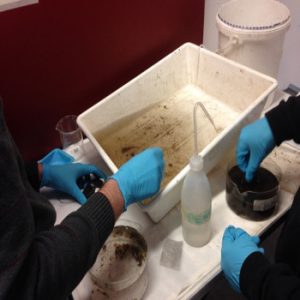In this post, we talk about our recently published paper “Long-term effects of fungicides on leaf-associated microorganisms and shredder populations – an artificial stream study”.

Leaves provided as food to the gammarids within units of the Laboratory Stream Microcosm Facility (photo by J. Zubrod)
In a post a few months ago, we introduced to you our Laboratory Stream Microcosm Facility, a unique testing facility that enables us to perform complex ecological and ecotoxicological studies under highly controlled environmental conditions. Now, our first paper was published about a study using this facility.
In this study, we assessed if the combined effects of fungicide-altered food quality and chronic exposure towards these fungicides via the water phase can affect the population development of Gammarus fossarum, a key leaf-shredder in many European streams. Gammarids were exposed chronically (i.e., for up to eight weeks) to a mixture of five fungicides (sum concentration 20 µg/L), while they received leaf material as food that had been microbially colonized in the presence of the same fungicide mixture. As response variables, population structure and fitness (abundance, biomass, lipid content, fatty acid composition, pairing, and juvenile production) as well as functioning (leaf breakdown, fine particulate organic matter production, and respiration) were monitored.

Counting animals (photo by J. Zubrod)
Gammarids responded to the combined stress from consumption of fungicide-affected leaves and waterborne fungicide exposure with a reduced abundance (up to 18%), which triggered reductions in final population biomass (18%) and in the number of precopula pairs (up to 22%). The reduced abundance could, however, not fully explain the decreased leaf consumption (19%), lipid content (up to 43%; going along with an altered composition of fatty acids), and juvenile production (35%). In contrast, fine particulate organic matter production and stream respiration were not affected. Our results indicate that chronic exposure of shredders and their food sources towards fungicides may result in detrimental implications in stream food webs and impairments of detrital matter fluxes. It thus seems to be of high importance to understand decomposer communities’ long-term adaptational capabilities to ensure that functional integrity is safeguarded.
The paper was authored by Jochen Zubrod, Dominic Englert, Jakob Wolfram, Ricki Rosenfeldt, Alexander Feckler, Rebecca Bundschuh, Frank Seitz, Marco Konschak, Patrick Baudy, Simon Lüderwald, Patrick Fink, Andreas Lorke, Ralf Schulz, and Mirco Bundschuh and published in Environmental Toxicology & Chemistry.
You may also be interested in:
Fungicides: do environmentally relevant concentrations affect reproduction in leaf-shredders?
